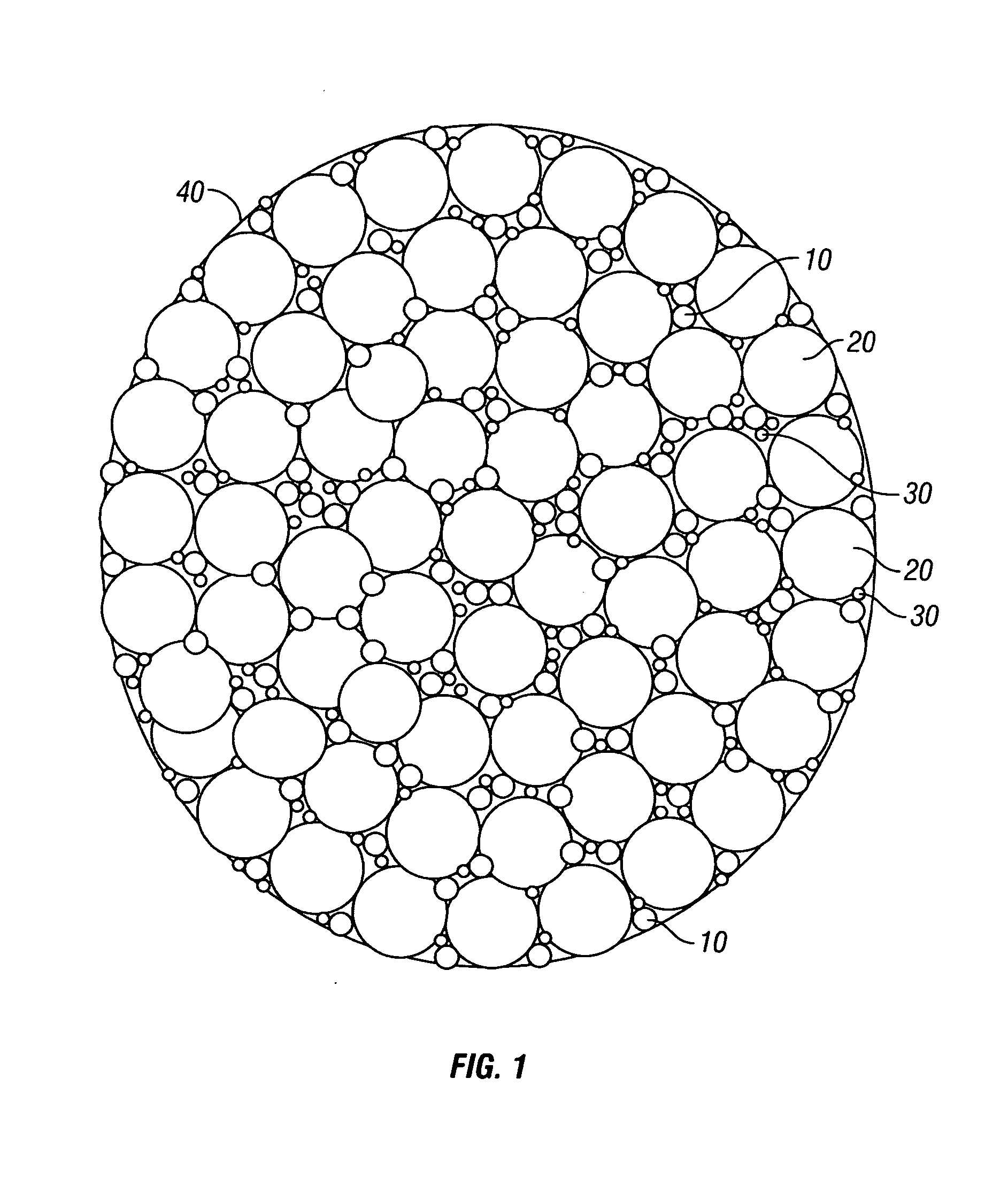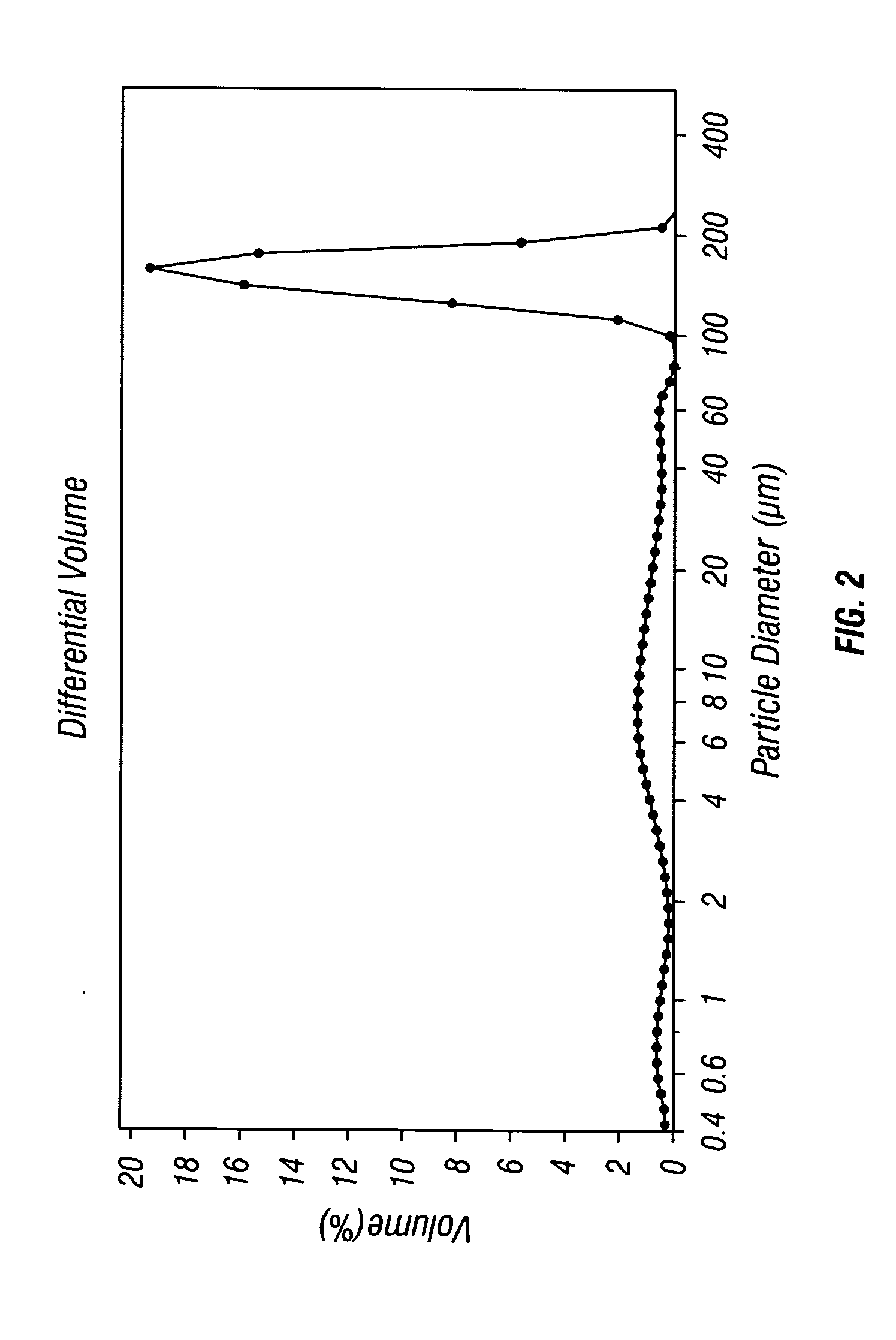Structured composite compositions for treatment of subterranean wells
a composite composition and subterranean well technology, applied in the direction of sealing/packing, well accessories, cellulosic plastic layered products, etc., can solve the problems of increasing the difficulty of proppant transport, reducing the volume of propped fractures, and reducing fracture conductivity, so as to improve stress tolerance, improve the strength of composites, and ensure the effect of structural strength
- Summary
- Abstract
- Description
- Claims
- Application Information
AI Technical Summary
Benefits of technology
Problems solved by technology
Method used
Image
Examples
example 1
[0060] The following composition results in an ultra lightweight proppant particle composite having a specific gravity of 1.28. The composite contains 10.7 volume percent (of composite) of phenolic resin binder having a specific gravity of 0.85. The particulates have a trimodal particle size distribution as set forth in Table I:
TABLE IVolume %Volume %SpecificComponentD50CompositeParticulatesGravityglass bubbles (10,000 psi) 30μ60.067.20.63silica flour 5μ21.624.22.65aluminum silicate0.8μ7.78.63.16
[0061] The particulates of the example exhibit resistance to closure stresses up to about 10,000 psi at bottom hole static temperatures (BHST) below the melting point of the resin. Manipulation of the compositions with alternative ASG components result in ultra lightweight proppant particles of widely varying ASGs. For example, replacement of the silica flour in the preceding example with hematite results in a particle having an ASG of about 1.84. Alternatively, replacing the aluminum sil...
example 2
[0062] A composite was prepared by mixing (i.) 17.5 volume percent of ceramic microspheres having a D50 of 4.8μ and a specific gravity of 2.4, commercially available as Zeeospheres™ spheres from 3M Corporation; (ii.) 17.5 volume percent of hollow glass spheres having a D50 of 12.8μ and a specific gravity of 1.1, commercially available as Sphericel® 110P8 hollow glass spheres from Potters Industries, Inc.; and 65 volume percent of ceramic microspheres having a D50 of 155.1μ and a specific gravity of 0.85.
[0063] Particle size analysis of the composite was performed on a Beckman Coulter LS PSA, using the Fraunhofer optical model, a dry powder module, a run length of 30 seconds and an obscuration of 6%. The particle size ranges of the three modalities are set forth in Table II:
TABLE II%Particle Ranges, μVolumeD500.400-1.9976.280.8771.997-85.1 26.89.75 85.1-249.667.1151.7
FIG. 2 is a graph showing frequency versus particle size of the multi-modal particulate composite. The first modali...
example 3
[0064] A composite mixture was prepared from the microspheres in Example 2 by adding 15 ml of distilled water to 35 ml of the ceramic hollow spheres having a D50 of 155.1 p. The mixture was stirred with a spatula and exhibited the consistency of wet sand such that the spatula was able to stand upright in the mixture. Next, 8 ml of Sphericel® 110P8 hollow glass spheres was stirred into the mixture. The resulting mixture became less viscous, even to the point of being flowable. The spatula was not able to stand upright. Then, 8 ml of the Zeeospheres™ were added. No noticeable change in viscosity was observed. The example illustrates the displacement of water by the components of the multi-modal composite and is indicative of the closely packed arrangement of the particulates in the composite.
PUM
 Login to View More
Login to View More Abstract
Description
Claims
Application Information
 Login to View More
Login to View More - R&D
- Intellectual Property
- Life Sciences
- Materials
- Tech Scout
- Unparalleled Data Quality
- Higher Quality Content
- 60% Fewer Hallucinations
Browse by: Latest US Patents, China's latest patents, Technical Efficacy Thesaurus, Application Domain, Technology Topic, Popular Technical Reports.
© 2025 PatSnap. All rights reserved.Legal|Privacy policy|Modern Slavery Act Transparency Statement|Sitemap|About US| Contact US: help@patsnap.com


